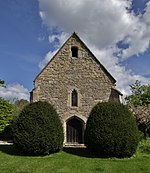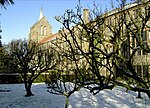The Friary, Oxford
1873 establishments in England19th-century Roman Catholic church buildings in the United KingdomBuildings and structures completed in 1873Former Church of England church buildingsFriaries in England ... and 8 more
Gothic Revival architecture in OxfordshireGothic Revival church buildings in EnglandGrade II listed buildings in OxfordGrade II listed churches in OxfordshireOrder of Friars Minor ConventualPrince Leopold, Duke of AlbanyReligious buildings and structures in OxfordRoman Catholic chapels in England

The Friary, formally known as Blessed Agnellus of Pisa Friary, formerly All Saints Convent or St John's Home is a centre of formation for the Franciscan Order of Friars Minor Conventual in Cowley, Oxford, England. The building was constructed in 1873 as the convent of the Anglican Society of All Saints Sisters of the Poor. It is situated between St Mary's Road and Cowley Road, next to St John's Care Home and Helen & Douglas House. The friary and its chapel are Grade II listed buildings.
Excerpt from the Wikipedia article The Friary, Oxford (License: CC BY-SA 3.0, Authors, Images).The Friary, Oxford
St Mary's Road, Oxford
Geographical coordinates (GPS) Address Nearby Places Show on map
Geographical coordinates (GPS)
| Latitude | Longitude |
|---|---|
| N 51.7442 ° | E -1.2336 ° |
Address
All Saints Convent
St Mary's Road
OX4 1RU Oxford
England, United Kingdom
Open on Google Maps








